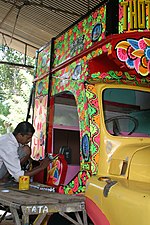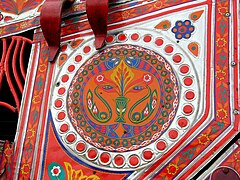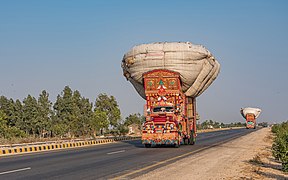|
Truck art in South Asia Truck art in South Asia is a popular form of regional decoration, with trucks featuring elaborate floral patterns and calligraphy.[1][2] It is especially common in Pakistan and India.[3] During the War in Afghanistan, Pakistani decorated trucks that ran services between Pakistan and Afghanistan came to be known as jingle trucks by American troops and contractors who were deployed across the latter country. History and originThe concept of decorating transportation and vehicles goes back to Indus valley civilization era, where people used different items for decorations on transportation,[4][dubious – discuss] in Sindh the art of transportation decoration is very ancient, back in time the wooden traditional Sindhi boats were beautifully carved with amazing designs and patterns, small mirrors were applied on it, the ivory inlaid, metal bells, Ghungroo, Phundra, beads, shells, colors and metal plates with dotted designs were used on boats and carts. The domestic animals used for different carts are also adorned with different jewelries which are specially made for these animals, Sindhis are very fond of decorating their domestic animals and spend a lot of money for it, such jewelries are usually made of different metals but Silver and gold is also used. Another art of transportation decoration is camel hair cut, the camels were common in allover Sindh, the locals cut the hair on its skin in different floral designs and geometric patterns, and apply henna and black color.[4][5][6][7] In early 20th century during British Raj the modern transportation like trucks were introduced in Sindh, in Karachi "General motors" first introduced trucks in 1930s, the locals started decorating these trucks, after partition Karachi became the biggest city and was hub of truck art.[4] The concept of truck art itself generally goes back to the 1920s during British rule over South Asia.[8][9] However, it wasn't until the 1950s in Karachi that it began to become widespread, by artist Hajji Hussain.[10] The term "jingle truck" is military slang that was coined by American troops serving in Afghanistan, although it may also date back to the British colonial period. The term came to be because of the jingling sound that the trucks make due to the chains and pendants hanging from the bumpers of the vehicles.[11] Practice Many trucks and buses are highly customized and decorated by their owners. External truck decoration can cost thousands of dollars.[12] The decoration often contains elements that remind the truck drivers of home, since they may be away from home for months at a time.[13] The art is a mode of expression for the truck drivers.[14] Decoration may include structural changes, paintings, calligraphy and ornamental-decor like mirror work on the front and back of vehicles and wooden carvings on the truck doors. Depictions of various historical scenes and poetic verses are also common.[15] Outfitting is often completed at a coach workshop.[16] Chains and pendants often dangle off the front bumper.[17] Religious iconography, poetry and political logos are also common.[3][18] PakistanThemesTruck art in Pakistan mostly features Islamic motifs and art as well Urdu poetry and political messages.[19] ArtistsTruck art has been called a "big business" in Pakistan, with around 250,000 people employed in the major centers as of 2014;[19] one of the most prominent truck artists is Haider Ali. Trained by his father from his youth, he first came to international attention in 2002 when he painted a Pakistani truck as part of the Smithsonian Folklife Festival.[20] Mr. Syed Phool Badshah, also known as Phool ji, is a well known truck artist who is best known for his unique style of doing Fine Arts with Truck art.[21] Regional styles In Pakistan, Karachi is a major city centre for truck art, though there are other hubs in Rawalpindi, Swat, Peshawar, Quetta and Lahore. The Karachi style has been called "disco art", with flashing bulbs, glass and mirrors.[19] Trucks from Balochistan and Peshawar are often heavily trimmed with wood, while trucks from Rawalpindi and Islamabad often feature plastic work. Camel bone ornamentation and predominance of red colours is commonly seen on trucks decorated in Sindh.[15] IndiaThemesIn India, motifs depicting eagles, kites, cow nuzzling calf and nazar battu, and catchphrases like "Horn OK Please", "Blow Horn" and "Use Dipper at Night" are frequently seen.[22] ArtistsNafees Ahmad Khan, a truck art artist in Indore, is well known throughout India and has been designing one truck every day for over thirty-two years.[14] Regional stylesIn India, the Delhi-based artist Tilak Raj Dhir states that the slogans he adds to his truck art, which is prevalent throughout the National Capital Region, often change with the socio-political atmosphere.[23] The state of Punjab is considered a major centre of truck art in India, with a distinctive style and expert artists.[24] Poetry is commonly seen in truck art across northern India, and particularly in Uttar Pradesh.[18] Truck art in Hindi and Urdu is sometimes called Phool Patti.[25][26] Influence Truck art has extended beyond the decoration and ornamentation of trucks into other forms and media. CarsThough cars are not traditionally decorated in South Asia, there are examples of cars embellished in a truck art style. In 2009, The Foxy Shahzadi, a 1974 VW Beetle decorated in a truck art style, travelled from Pakistan to France in a 25-day journey.[27][28] In the Indian city of Mumbai, some drivers decorate their taxis in a truck art style.[29] BusesThe buses in Asia are colorful wonders to behold. They are decorated with fancy paintings that blend spiritual images with nature motifs. In Pakistan, these ornate buses and trucks feature beloved folk art. The so-called "jingle trucks" of Pakistan showcase this art tradition all over the country. Each vehicle displays complex designs and patterns, made by talented local artisans.[30] FashionThe lively colours of Pakistani trucks have inspired some fashion designers.[31] The Italian fashion company Dolce & Gabbana used truck art-inspired displays in a 2015 campaign.[32] Although used more often on women's fashion, some men's clothing have been inspired by South Asian truck art.[33] Apart from clothing, truck art has also been incorporated into shoes by some.[34] Print DesignFarid Bawa, an Indian graphic designer, collaborates with Indian truck artists to make and sell prints of truck art online in a bid to preserve the tradition of truck art.[35] Gallery
See alsoReferences
External linksWikimedia Commons has media related to Decorated trucks in Pakistan. Wikimedia Commons has media related to Decorated trucks in India. Wikimedia Commons has media related to Decorated trucks in Afghanistan. Wikimedia Commons has media related to Decorated vehicles in Pakistan. Wikimedia Commons has media related to Jingle trucks. |
Portal di Ensiklopedia Dunia








![The phrase "Horn Please" is used extensively in Indian truck art.[3]](http://upload.wikimedia.org/wikipedia/commons/thumb/f/fc/Indiatruck.jpg/240px-Indiatruck.jpg)
















